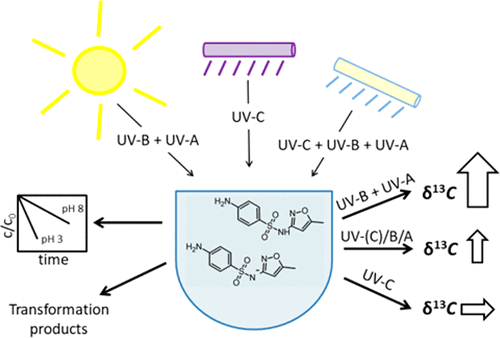当前位置:
X-MOL 学术
›
Environ. Sci. Technol.
›
论文详情
Our official English website, www.x-mol.net, welcomes your
feedback! (Note: you will need to create a separate account there.)
Direct Photolysis of Sulfamethoxazole Using Various Irradiation Sources and Wavelength Ranges—Insights from Degradation Product Analysis and Compound-Specific Stable Isotope Analysis
Environmental Science & Technology ( IF 10.8 ) Pub Date : 2018-01-18 00:00:00 , DOI: 10.1021/acs.est.7b04744 Sarah Willach 1 , Holger V. Lutze 1, 2, 3 , Kevin Eckey 4 , Katja Löppenberg 1 , Michelle Lüling 1 , Jens-Benjamin Wolbert 1 , Dorothea M. Kujawinski 1 , Maik A. Jochmann 1, 3 , Uwe Karst 4 , Torsten C. Schmidt 1, 2, 3
Environmental Science & Technology ( IF 10.8 ) Pub Date : 2018-01-18 00:00:00 , DOI: 10.1021/acs.est.7b04744 Sarah Willach 1 , Holger V. Lutze 1, 2, 3 , Kevin Eckey 4 , Katja Löppenberg 1 , Michelle Lüling 1 , Jens-Benjamin Wolbert 1 , Dorothea M. Kujawinski 1 , Maik A. Jochmann 1, 3 , Uwe Karst 4 , Torsten C. Schmidt 1, 2, 3
Affiliation

|
The environmental micropollutant sulfamethoxazole (SMX) is susceptible to phototransformation by sunlight and UV-C light which is used for water disinfection. Depending on the environmental pH conditions SMX may be present as neutral or anionic species. This study systematically investigates the phototransformation of these two relevant SMX species using four different irradiation scenarios, i.e., a low, medium, and high pressure Hg lamp and simulated sunlight. The observed phototransformation kinetics are complemented by data from compound-specific stable isotope and transformation product analysis using isotope-ratio and high-resolution mass spectrometry (HRMS). Observed phototransformation kinetics were faster for the neutral than for the anionic SMX species (from 3.4 (LP lamp) up to 6.6 (HP lamp) times). Furthermore, four phototransformation products (with m/z 189, 202, 242, and 260) were detected by HRMS that have not yet been described for direct photolysis of SMX. Isotopic fractionation occurred only if UV-B and UV-A wavelengths prevailed in the emitted irradiation and was most pronounced for the neutral species with simulated sunlight (εC = −4.8 ± 0.1 ‰). Phototransformation of SMX with UV-C light did not cause significant isotopic fractionation. Consequently, it was possible to differentiate sunlight and UV-C light induced phototransformation of SMX. Thus, CSIA might be implemented to trace back wastewater point sources or to assess natural attenuation of SMX by sunlight photolysis. In contrast to the wavelength range, pH-dependent speciation of SMX hardly impacted isotopic fractionation.
中文翻译:

各种辐照源和波长范围对磺胺甲恶唑的直接光解—降解产物分析和特定化合物稳定同位素分析的启示
环境微污染物磺胺甲基异恶唑(SMX)易受阳光和用于水消毒的UV-C光的光转化。根据环境pH条件,SMX可能以中性或阴离子形式存在。这项研究使用四种不同的照射场景,即低,中,高压汞灯和模拟阳光,系统地研究了这两种相关的SMX物种的光转化。观察到的光转化动力学被化合物特异性稳定同位素的数据和使用同位素比率和高分辨率质谱(HRMS)的转化产物分析所补充。中性的观察到的光转化动力学比阴离子的SMX物种快(从3.4(LP灯)到6.6(HP灯)倍)。此外,m / z 189、202、242和260)已通过HRMS进行了检测,尚未针对SMX的直接光解进行描述。如果UV-B和UV-A波长所发射的照射盛行只发生同位素分馏和最显用模拟太阳光的中性物质(ε c ^ = -4.8±0.1‰)。用UV-C光对SMX进行光转化不会引起明显的同位素分馏。因此,可以区分太阳光和UV-C光诱导的SMX的光转化。因此,可以实施CSIA追溯废水点源或评估日光光解对SMX的自然衰减。与波长范围相比,SMX的pH依赖性物种几乎不影响同位素分馏。
更新日期:2018-01-18
中文翻译:

各种辐照源和波长范围对磺胺甲恶唑的直接光解—降解产物分析和特定化合物稳定同位素分析的启示
环境微污染物磺胺甲基异恶唑(SMX)易受阳光和用于水消毒的UV-C光的光转化。根据环境pH条件,SMX可能以中性或阴离子形式存在。这项研究使用四种不同的照射场景,即低,中,高压汞灯和模拟阳光,系统地研究了这两种相关的SMX物种的光转化。观察到的光转化动力学被化合物特异性稳定同位素的数据和使用同位素比率和高分辨率质谱(HRMS)的转化产物分析所补充。中性的观察到的光转化动力学比阴离子的SMX物种快(从3.4(LP灯)到6.6(HP灯)倍)。此外,m / z 189、202、242和260)已通过HRMS进行了检测,尚未针对SMX的直接光解进行描述。如果UV-B和UV-A波长所发射的照射盛行只发生同位素分馏和最显用模拟太阳光的中性物质(ε c ^ = -4.8±0.1‰)。用UV-C光对SMX进行光转化不会引起明显的同位素分馏。因此,可以区分太阳光和UV-C光诱导的SMX的光转化。因此,可以实施CSIA追溯废水点源或评估日光光解对SMX的自然衰减。与波长范围相比,SMX的pH依赖性物种几乎不影响同位素分馏。











































 京公网安备 11010802027423号
京公网安备 11010802027423号